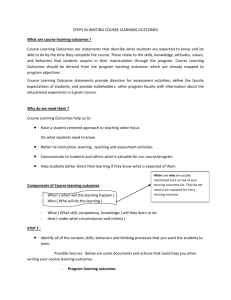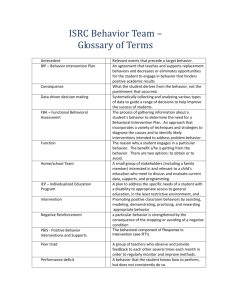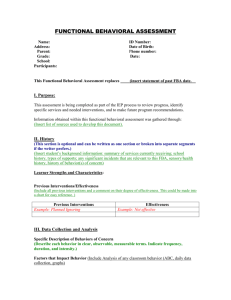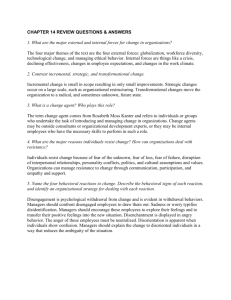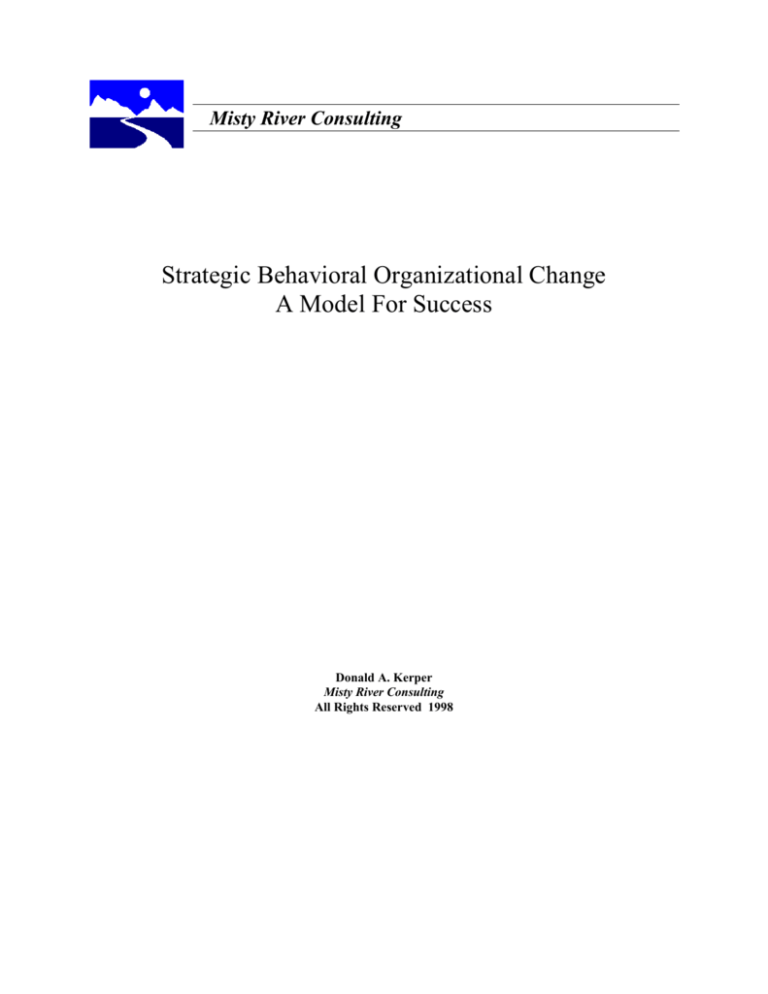
Misty River Consulting
Strategic Behavioral Organizational Change
A Model For Success
Donald A. Kerper
Misty River Consulting
All Rights Reserved 1998
Strategic Behavioral Change Interventions
The effectiveness and efficiency of overall organizational behavior is what defines
success or failure for any business. Often times, the organization finds that its behavior is not
leading to success and consequently needs to be changed. Not surprisingly, the organization’s
leadership will attempt to identify a new set of desired behaviors and develop a plan that leads to
the performance of those behaviors that is hoped will lead to improved organizational
performance.
The Desired Behavior
Any given change strategy needs to result in a new set of defined individual behaviors
that collectively lead to organizational behavior that is more effective and efficient in achieving
its stated goals. What new behavior is specifically needed is dependent upon the competitive
position of the organization and its efficiency in obtaining its results.
Whatever the final desired behavior is, the following “organizational change behaviors”
are necessary to implement the change. Top management makes the decision to proceed,
identifies the needed desired behaviors, develops the plan, and provides the resources for the
change initiative. Middle management often times makes actionable top management’s plan and
then implements the plan. Supervisors follow the plan’s lead and facilitate the employees in
their attempts to perform in the desired manner. Employees perform the desired behaviors that
hopefully lead to improved effectiveness and efficiency and provide the feedback about how the
plan needs to be modified to improve the organization’s ability to behave in the new way.
The Strategic Behavioral Change Process
Since organizational behavior is the cumulative sum of individual behavior, the change
agent must address it appropriately. Traditionally, training has been the single most used tool for
changing behavior. Unfortunately, training, in and by itself, is very ineffective in changing
organizational or individual behavior.
Changing organizational and individual behavior is a comprehensive process that
includes identifying the desired organizational and individual behaviors people are to perform
and developing a change plan that leads to the performance of the new behaviors. These
behaviors and the plan are grounded in the strategic plan that provides a visible and actionable
plan for all employees. From the strategic plan, all employees gain a clear view of the
organization’s objectives and a clear and concise view of what they are expected to do as a
result.
The ability to create clarity and consensus about the objective and the process to achieve
that objective from either a corporate view or an individual point of view is grounded in and
derived from the strategic plan of the organization.
Once the desired behaviors are identified and integrated into the strategic plan, an
organizational assessment is performed on three fronts. The first front assesses the competency
of all employees to perform the new behaviors. It looks for the skill or knowledge gaps that
people have that would constrain them from knowing how to perform in the desired fashion. In
addition, this assessment will get a feel for the degree that these individuals are ready for change
and perceive a need to change to something different.
The Strategic Behavioral Change Process
Management
Awareness Building
Management
Decision Making
Identification of
Desired
Organizational &
Individual Behavior
Strategic / Tactical
Organizational
Charnge Planning
Competency
Assessment
Infrastructure
Assessment
Behavioral
Reinforcer
Assessment
Training /
Competency
Development Plan
Organizational
Development Plan
Plan Implementaton
New Behavior
Performance
Appropriate
Adjustment of the
Above
Measurement &
Evaluation
The second assessment front looks at the infrastructure of the organization and looks for
the organizational elements that either constrain or prevent the new behaviors from being
practiced. What the organization’s leadership would like to do is create an infrastructure that
enables - not constrain - people to perform in the desired fashion.
The third assessment front is focused on the things that reward or reinforce, either
positively or negatively, the demonstration of the desired behavior. These items do not affect the
competency of the individuals in the organization nor enable people to perform in the proper
way. The behavioral reward and reinforcements provide the appropriate feedback to individuals
about whether their behavior is appropriate or not.
Once the gaps in competency, infrastructure, or behavioral reinforcement or rewards are
identified, the top management group can facilitate the development of a training and
development plan that eliminates the competency constraints. In addition, an organizational and
development plan can also be developed that changes the infrastructure’s ability to enable people
to perform in the new way and that changes the behavioral reinforcers and rewards so that people
are reinforced and rewarded appropriately for the behavior they do exhibit.
Finally, its time to execute. The new behaviors have been targeted, the plans for
developing the competency of individuals and for developing the infrastructure and behavioral
reinforcers is in place. With these change plans in place, management states the objectives and
expectations for people, creates an understanding about why the change is necessary, creates an
understanding of the change plan, and then “kicks off” its implementation.
As the plan unfolds, one expects the new behaviors to be demonstrated with increasing
frequency and effectiveness. As they are demonstrated, management evaluates the effectiveness,
efficiency, and performance frequency of these behaviors and acts accordingly to modify the
plans or strategies that would improve the ability to get the new behaviors performed.
Change Agent Primary Activities
In order for the strategic change initiative to be successful, the change agent will find him
or herself providing one or more of the following services during the course of the change
process for the targeted organization and its management:
* Facilitation of strategic and tactical planning.
*
Organizational diagnosis to identify "gaps" in organizational effectiveness,
efficiency, or improvement strategies.
*
Identification of needed organizational and individual behaviors.
*
Facilitation of behavior change planning.
*
Assessment of competency development needs.
*
Design and deliver of the needed training including "train the trainer".
*
Assessment of the organization's
characteristics, and processes.
*
Design and deliver of the needed organizational development changes that provide
for the organization’s infrastructure and behavioral reinforcement characteristics.
*
Coaching, Guidance, and Evaluation of the change process initiative.
infrastructure,
behavioral
reinforcement
All of these things are systematically addressed to insure that people develop the
competency to perform and are enabled and reinforced to perform in the desired fashion in a
planned and controlled fashion. The performance of the total organizational will improve as the
individual pieces come together through competency development and performance enablement.
Appendix:
Competency Issues
Possible Skill or Knowledge Gaps
Problem solving skills
Leadership and/or management skills
Facilitation skills
Presentation skills
Listening skills
Team functioning skills
Computer skills
Financial & cost accounting knowledge & skills
Cost accounting knowledge & skills
Project management skills
Technical knowledge & skills
Strategic or tactical objectives knowledge
Values, beliefs, philosophy knowledge
Customer satisfaction & need knowledge
Competitive position knowledge
Cross functional knowledge
Specific job expectation knowledge
Infrastructure Issues
Possible Infrastructure Constraints
Financial and cost information system
Process performance information system
Meeting room and supplies
Time for people to perform
Crewing or staffing adaptability
Lack of resources (computers, etc.)
Cross functional walls
Maintenance & Engineering planning & execution
Leadership proximity & availability
Behavioral Reinforcement Characteristic Issues
Possible Behavioral Reinforcement Char. Gaps
Job descriptions and expectations
Reports on process performance
Reports on cost
Reports on customer needs, complaints, etc.
Lack of policy, value, or belief statements
Performance planning & appraisal system
Bonus/Compensation system
Sense of urgency
Peer Pressure
Habit/Tradition
Periodic review/evaluation of situation
Strategy for Eliminating Gap
Strategies for Eliminating Constraints
Strategies for Eliminating Gaps
Many more of the above could be listed. This is an abbreviated list of the primary issues.
The Strategic Behavioral Change Process
Top Mgmt
Awareness Building
and Decision
Making
Identification of
Desired
Behaviors
Strategic
Planning
Infrastructure
Assessment
Possible Infrastructure Constraints
Financial and cost information system
Process performance information system
Meeting room and supplies
Time for people to perform
Crewing or staffing adaptability
Lack of resources (computers, etc.)
Cross functional walls
Maintenance & Engineering planning & execution
Leadership proximity & availability
Reward or
Reinforcement
Characteristic
Assessment
Possible Behavioral Reinforcement Characteristic Gaps
Job descriptions and expectations
Reports on process performance
Reports on cost
Reports on customer needs, complaints, etc.
Lack of policy, value, or belief statements
Performance planning & appraisal system
Bonus/Compensation system
Sense of urgency
Peer Pressure
Habit/Tradition
Periodic review/evaluation of situation
Individual
Competency
Assessment
Organizational
Development
Plan
Training and
Development
Plan
Plans
Implemented
Evaluation
Performance
of New
Behaviors
Possible Skill or Knowledge Gaps
Problem solving skills
Leadership and/or management skills
Facilitation skills
Presentation skills
Listening skills
Team functioning skills
Computer skills
Financial & cost accounting knowledge & skills
Cost accounting knowledge & skills
Project management skills
Technical knowledge & skills
Strategic or tactical objectives knowledge
Values, beliefs, philosophy knowledge
Customer satisfaction & need knowledge
Competitive position knowledge
Cross functional knowledge
Specific job expectation knowledge



